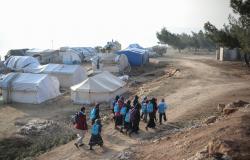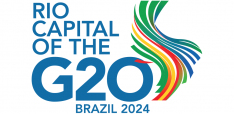Is it right to prioritise fragile states in the climate crisis?

Hugo Slim argues that climate justice must be at the heart of decisions on where to allocate climate finance.
In the run-up to COP 28, humanitarian agencies are advocating hard for climate finance to be invested in countries affected by fragility, conflict and violence (FCV). Quite rightly, they argue that millions of people in these countries are often the poorest of the poor and overlooked by climate funders.
People in FCV states are disproportionately affected by multiple emergencies – climate, conflict and displacement. Mitigation and adaptation investments made in war zones can be destroyed or abandoned if violence flares around them and they are fought over as valuable assets. FCV populations usually have the worst systems of government support. All this means they are bypassed by climate finance and other development funds as too high risk for a reliable return on investment.
Humanitarians – who work mostly in FCV states – are determined that these people should not be overlooked, and that climate justice should apply to them as well. They are urging climate financiers to see risk differently.
The spectre of triage in climate finance
But do reluctant climate financiers have a valid point? The ethical problem of investing in dangerous places is genuinely difficult. It is also haunted by a ghost that nobody yet wants to see in climate policy. The ghost, of course, is triage, a moral agony that, even so, can be ethically necessary in extreme conditions. If you cannot help everyone and FCV communities are so difficult to help, then maybe it is better to fund others who are easier to help. Perhaps it is wrong to invest in high-risk places when the same money could be used to better and quicker effect in other places where millions of other people are also vulnerable, and where climate investments will stand a better chance of delivering successful mitigation and adaptation.
Bankers always triage. Humanitarians hate having to do it. But we need to acknowledge the possibility of triage of various kinds in the climate emergency and test for its necessity or not.
A time for trying and not for triage
This is not the time for triage. Humanitarians are right that climate funders have a moral obligation at this moment in the climate emergency to try very hard to invest in FCV communities. There are three strong reasons for this.
First, these next few years are a critical time to learn how best to support the survival and adaptation of extremely vulnerable communities. Many more places and billions more people will become extremely vulnerable in the 2030s, and now is the time to work out the best ways to help them. Strategies being proposed by humanitarians for FCV states – like locally led aid, different risk thresholds and disaster-related surge funding – have not yet been comprehensively tried. We have an obligation to see if they produce significant gains.
Second, we know the major challenges in FCV states, and some of them may be manageable. This means we cannot plead ignorance, insurmountable obstacles or insufficient capacity as a reason for walking away.
- One challenge is near-term bias in the policy attention of FCV leaders and people in places like Sudan and Myanmar, who are unsurprisingly more preoccupied with fighting wars and ensuring their everyday survival than in thinking in the medium and longer term about climate mitigation and adaptation. Perhaps a critical mass of political and community attitudes can be changed as they experience more pressing climate-related hazards, and have the incentive of financial support. We must find out.
- Another challenge is the absorptive capacity of weak or corrupt governments and communities to receive and responsibly use significant climate finance. This requires a creative medium-term strategy of locally led institution-building and patient capital that focuses on eventual resilience and not quick wins. This may well be doable in some places, especially when not every part of an FCV state is conflict-affected. We have to try.
- The extreme environments of FCV states means there is very low adaptation potential. Many people are already so poor from war and displacement, and many places are now increasingly uninhabitable as a result of recurring drought, cyclones, floods and violence, that adaptation options are zero or extremely limited. Millions of people are therefore defaulting to last-resort forms of adaptation, like internal migration and urbanisation. This means climate finance has a clear obligation to support ‘managed retreat’ in many FCVs. This is a strategy that will become increasingly necessary in many parts of the world in the 2020s and beyond, so it makes sense to get good at it now.
It would be wrong not to try to make these three things work to help people in need today and learn better how to help billions more tomorrow. Just as wartime extremes of starvation, food rationing, family separation and urban evacuation have informed later global policies, so climate action in FCV states today could guide global policy when billions, not millions, are living right on the edge.
Third, climate finance is already skewed and needs correction before it entrenches unfair adaptation in favour of the rich. IFRC’s excellent report reveals an ‘adaptation gap’ as most climate finance is clustered in the least vulnerable states. Because it is easier and lower risk, climate financiers clearly prefer investing in countries that are already rich and relatively stable. This may make sense when investment is driving major mitigation transitions from carbon-based to green energy in heavily industrialised societies. But very often these countries could pay for this themselves, and should do so because of their disproportionate contribution to global warming.
If this skewed trend in the investment portfolios of climate funds continues, it will see global climate action stuck in path-dependent spending which may be globally maladaptive. It will prioritise adapting the rich stable world in ways the majority world cannot follow, while failing to invest in renewables, water supply, food security and well-managed retreat for poorer parts of the world. This is not climate justice.
It is not just FCV populations who are extremely vulnerable
Finally, a word of caution is needed in case successful humanitarian lobbying at COP 28 turns policy neglect of FCV states into a new policy obsession.
FCV states must be in the frame for climate finance but they should not come to dominate the debate about who needs it most. FCV populations are still a minority in the much wider challenge of climate vulnerability. Large parts of Asia, the Pacific, Africa, Latin America and even North America and Europe, whose names are not on the World Bank list of FCV states, have huge populations that are extremely vulnerable to climate crisis.
It is essential that people in FCV states get their fair share of finance and programming attention but, in the process, they must not mesmerise policy and spending. An over-emphasis on FCVs would not be climate justice either.
Hugo Slim leads the ‘What is Climate Humanitarianism?’ project at the Las Casas Institute for Social Justice at Blackfriars Hall, University of Oxford. The project is funded by the national Red Cross societies of Germany, Denmark and UK, and by Caritas Germany, Trocaire and CRS.
This article first appeared on the Humanitarian Practice Network is co-published by HPN and the Centre for Humanitarian Action (CHA)
Photo by Khaled Akacha


